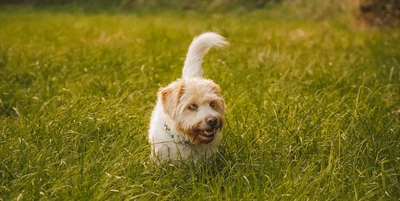Dental Health In Dogs
- 17 Aug 2020
- 4m read

Eating, drinking, playing tug rope - your dog’s teeth have a tough job. Plaque and tartar build-up can create an ideal environment for bacteria to set up home in your dog’s mouth leading to smelly breath, infected gums, dental pain or a root abscess and in severe cases, damage to your dog’s internal organs. Latest research has proved the very best way to care for your dogs dental health is good old-fashioned brushing.
Many owners are reluctant to brush their dog's teeth as they feel their dog won't like it, but most respond well and actually enjoy the new fuss, not to mention, most doggy toothpastes are really tasty.
Prevention is always better than cure, so introduce a dental routine as a puppy so he or she grows up feeling it’s normal routine.
How Many Teeth Do Dogs Have?
On average, adult dogs have 42 teeth, made up of incisors, canines, premolars, and molars. Although, the exact number can vary depending on the breed and individual anatomy.
These teeth serve various functions, including chewing, tearing, and grasping food. Understanding the layout of your dog's teeth can help you better care for their oral health and identify any abnormalities or issues that may arise.
Should I Clean My Dog's Teeth?
Yes, regular dental care is essential for maintaining your dog's oral health.
While dogs don't brush their teeth like humans do, you can help keep their teeth clean by brushing them regularly with a dog-specific toothbrush and toothpaste.
Doing so reduces plaque buildup, tartar accumulation, gum disease, and tooth decay. Neglecting dental care can lead to discomfort, pain, and even more severe health complications over time. Consult your vet for guidance on the best practices for cleaning your dog's teeth at home and scheduling professional dental cleanings when necessary.
How to Keep Your Dog’s Teeth Clean
There are several other ways to promote good oral hygiene in your dog. These include:
Brushing
Just like humans, dogs benefit greatly from regular tooth brushing. Use a soft-bristled toothbrush and dog-friendly toothpaste to gently clean your dog's teeth, aiming for at least two to three times per week.
Dental chews and toys
Incorporate dental chews rich in seaweed and toys specifically designed to promote oral health into your dog's routine. These products help reduce plaque and tartar buildup while providing mental stimulation and entertainment.
Water additives
Water additives for dogs typically contain ingredients such as enzymes, antimicrobial agents, and plaque-fighting compounds. When added to your dog's water bowl, these additives mix with the water and are ingested as your dog drinks.
As your dog swallows the treated water, the active ingredients work to inhibit the growth of bacteria in their mouth, reduce plaque and tartar accumulation, and freshen their breath
Balanced diet
Nutrition plays a significant role in dental health. Opt for high-quality dog food that supports dental hygiene, such as fresh dog food.
Regular vet check-up
Schedule routine dental examinations with your veterinarian to monitor your dog's oral health and address any emerging issues promptly.
How to Brush a Dog's Teeth
Keep each brushing session short. To start, gently stroke your dog’s cheek for a minute or two whilst they get used to the action. For the next few days, let them lick a small amount of toothpaste from your finger too. Next, rub some toothpaste on your dog's gums.
Using a regular flat head toothbrush, build this up to gently brushing their teeth. Of course, you should take care when putting your fingers into your dog’s mouth. We don’t recommend doing so if your dog is likely to become annoyed and snap out of frustration.
Are Dental Sticks Good for Dogs?
Many dental sticks rely solely on abrasion to break-down plaque and tartar. However, it is much more beneficial to opt for a dental stick that uses natural ingredients to reduce buildup, such as seaweed.
Seaweed contains compounds that may help inhibit the growth of bacteria in the mouth, reducing the risk of dental decay and bad breath. Furthermore, seaweed is rich in nutrients such as calcium and magnesium, which are essential for maintaining strong teeth and bones.
Butternut Box’s smile sticks are the perfect addition to your dog’s daily routine to help maintain their dental hygiene.
Do Dogs' Teeth Fall Out?
Like humans, dogs have two sets of teeth in their lifetime: puppy teeth and adult teeth.
Puppy teeth typically start to fall out around 3 to 4 months of age as adult teeth begin to emerge. By the time a dog reaches 6 to 7 months old, they should have all of their adult teeth. While it's normal for puppy teeth to fall out, adult teeth should not.
If you notice any loose or missing teeth in your adult dog, it could indicate an underlying dental issue that requires veterinary attention.
Signs of Dental Problems in Dogs
Signs of dental problems in dogs can vary, but common indicators include:
Bad breath
Swollen or bleeding gums
Discoloured teeth
Excessive drooling
Difficulty eating or chewing
Pawing at the mouth
Reluctance to play with toys
Change in behaviour (irritability/aggression)
Tartar build up
Loose or missing teeth




